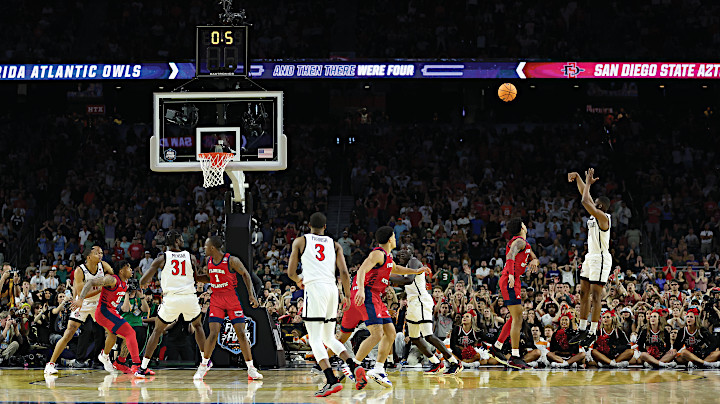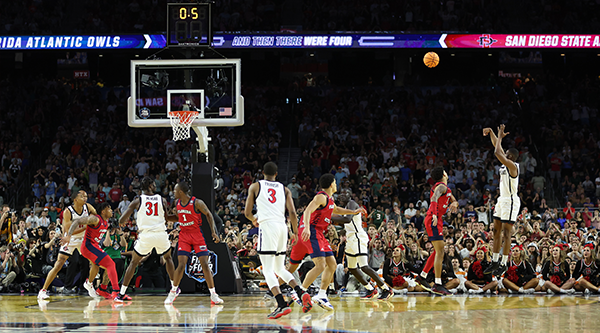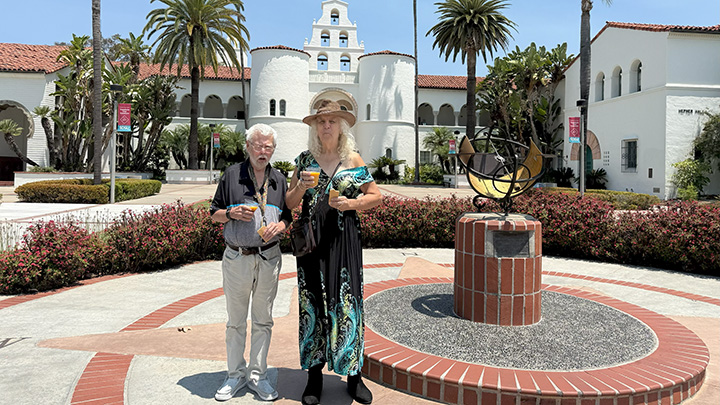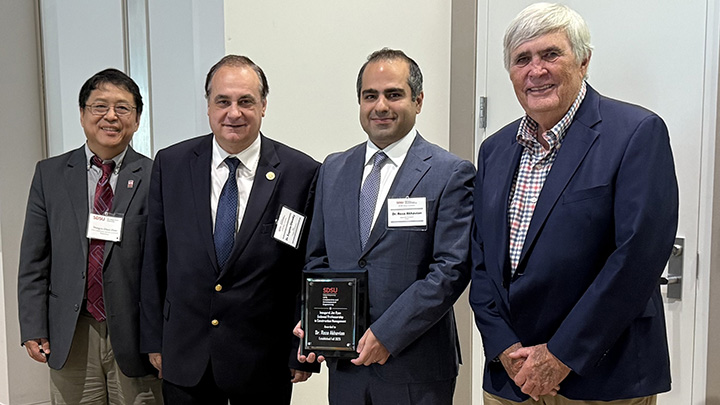SDSU Year in Review 2023
2023 was a year of high achievements with faculty, staff, student leaders and administrators building on decades of previous work.

New highs in research funding and philanthropy. Development of a river park at SDSU Mission Valley, and a thoroughly renovated Performing Arts District. A long-sought and newly opened door to independent doctoral degrees.
And, that miracle buzzer-beater in the men’s NCAA semifinal that when it splashed through the net, a wave of crimson and black swept across the globe to create unprecedented exposure exciting legions of alumni, fans and supporters who waited decades to take their place on college sport’s main stage.
San Diego State University leaps into 2024 after an exhilarating 2023. This was a year of high achievements with faculty, staff, student leaders and administrators building on decades of previous work.
Here is a look at some of SDSU’s highlights of 2023 (in no particular order):
Independent Doctorates
In a historic update to California’s 1960 Master Plan for Higher Education, Gov. Gavin Newsom in October signed legislation giving SDSU and other California State University (CSU) campuses the authority to implement their own professional and applied doctoral degrees. Previous law permitted only joint doctorates, mainly through programs with the University of California, and the move came on the heels of 2022 legislation authorizing independent Doctor of Public Health programs at CSU.
SDSU and President Adela de la Torre had championed the proposal. SDSU expects to move forward quickly with initial program offerings.
“This is a revolutionary change for our system and for SDSU,” de la Torre said. “Our excitement for what this means for our students, faculty and state cannot be overstated.”
New Growth at SDSU Mission Valley
Be among the first to explore the restored natural beauty of the new 34-acre river park at SDSU Mission Valley. This inviting new space is filled with modern recreational opportunities for the surrounding community.
Restored native habitats, miles of walking and biking trails, basketball courts and a children’s play area are among the many enhancements to the formerly flood-prone site just north of the San Diego River. Designed with input from the community and environmental groups, the park includes interpretive displays including information about Mission Valley’s Kumeyaay origins, the San Diego River, plants, animals and biological habitat.
Also, in November, the CSU Board of Trustees approved the development’s first affordable housing and a market-rate residential and retail project.
Snapdragon Stadium continued to be the home of Aztec Football, the San Diego Wave Fútbol Club and hosted the National Women’s Soccer League championship in November. A Major League Soccer team will take up residence at Snapdragon beginning in 2025. And Jimmy Buffet’s encore rendition of “Southern Cross” in a May 6 concert at Snapdragon was the tropical-rock musician’s last San Diego performance with the Coral Reefers before his death on Sept. 1.
Performing Arts District Opening
SDSU’s Performing Arts District raised the curtain to its renovated Main Stage Theatre in October with the production of “Children of Eden.”
The renovation of the 491-seat interior includes ADA accessibility upgrades, improved audience sightlines, special acoustic tiles for optimal sound quality, and state-of-the-art technology.
Plans for the Main Stage renovations and the creation of the SDSU Performing Arts District started in early 2019. The Main Stage (previously the Don Powell Theatre) had not seen a significant update since 1967.
In addition to the SDSU Main Stage, the Performing Arts District offers four new performance and patron structures: the Prebys Stage, the Dean Joyce M. Gattas Amenities Pavilion, the outdoor Bill and Evelyn Lamden Stage and the Ben and Nikki Clay Stage, as well as the Julia R. Brown Family Park.
The district is set to become a regional powerhouse in training and performance and a vibrant hub for collaboration. It brings together various disciplines and provides students with state-of-the-art facilities to nurture artistic talents and innovation.
Remarkable Philanthropic Generosity
Donors provided $136.9 million in gifts and commitments to SDSU in 2022-23, the year ending June 30. Their generosity benefits student scholarships, capital projects, research, athletics, departments and programs, KPBS and more.
Planned gifts, to be delivered through donors’ estates, represent many of the most transformative contributions to SDSU’s future. Faculty Emerita Anne Verderber Taylor of the School of Nursing, for example, established an endowment to support nursing faculty academic research, recognizing its value in fostering early-career faculty, and boosting their competitiveness for grants.
The J.W. Sefton Foundation provided a grant in support of the SDSU Water Monitoring Project, enabling impactful and critical research collaborations to help ensure a clean water supply for the San Diego region.
Furthermore, SDSU acknowledged numerous outright gifts from generous donors. In July, the university announced a $3 million endowment from alumnus Frederick W. Pierce IV ('84, '88) and Christine F. Pierce to enhance and help sustain fraternity and sorority life. The Pierce Greek Life Center, dedicated August 15, serves as a focal point for extending leadership skill development and access to fraternity and sorority life to a broader range of students.
In November, SDSU announced a $2.5 million gift to endow the Jessica P. Sarowitz Guardian Scholars Center. Guardian Scholars serves students who are current or former foster youth, wards of the court, under legal guardianship or unaccompanied homeless youths; and supports their transition to, through and beyond SDSU.
“As we reflect on the transformative impact of the remarkable philanthropic gifts made in 2023, we are profoundly grateful for the vision and generosity of our benefactors,” said Vice President of University Relations and Development Adrienne Vargas. “These extraordinary contributions exemplify a shared commitment to advancing education, fostering inclusivity, and empowering the dreams of our students.”
Research and Innovation
SDSU researchers scored a record $192.2 million in funding in 2022-23, a 17% increase over the previous fiscal year, with federal funding sources that include the National Institutes of Health (NIH), the National Endowment for the Arts and the U.S Department of Agriculture.
Funding for Hispanic-Serving Institution-specific initiatives such as involving students in research on drones and training more bilingual teachers increased to a record-high $10.4 million.
Some 368 principal investigators received 805 awards from more than 300 local, state and federal agencies as well as non-profit foundations and for-profit companies.
SDSU researchers tracked health disparities hotspots around the region and led the nation in studying K-pop dance theoretically and practically. Doctoral students unearthed the history of earthquakes in the Salton Sea and undergraduates increased accessibility of language learning resources. Through established partnerships, faculty removed roadblocks for the autism community, spearheaded environmental justice initiatives, and addressed mental health through art.
SDSU continued to foster new ideas and companies. Faculty inventors contributed to nearly 40 new patent applications and were issued 10 new patents. The ZIP Launchpad, SDSU’s on-campus startup incubator, was nationally recognized for exemplary entrepreneurship education. Founders from around the world honed their business plans and connected with SDSU’s vast network of local mentors through the Techstars San Diego powered by SDSU accelerator.
“At every level, SDSU researchers are generating new insights and solutions that truly serve diverse communities, usually side-by-side as valued partners,” said Vice President for Research and Innovation Hala Madanat.

SDSU Imperial Valley
It was a year of strong, continued momentum at SDSU Imperial Valley as it broadened its educational mission and services to the heavily Latinx residents of Imperial County.
The CSU Board of Trustees approved the schematic design for a Sciences and Engineering Laboratories building, scheduled for completion in fall 2025. The project is part of $80 million in state funding to bolster STEM education and research, making SDSU Imperial Valley a key player in the region’s aspirations to become deeply involved in the extraction and uses of lithium found near the Salton Sea.
The university announced a bachelor of science in public health degree program, to be launched next fall. The new program expands career opportunities, advocacy and research in a region long plagued with health disparities.
The 2023-24 state budget includes $11.6 million toward a joint student housing project with Imperial Valley College. Set to break ground in early 2025, the project calls for a total of 40 single- and double-occupancy rooms at the Calexico campus.
A new $235,000 grant will enable researchers to study the impact of biomass burnings across the border on air quality in Imperial and San Diego counties.
New Names For Campus Landmarks
In separate ceremonies, two prominent figures in SDSU history — veteran astronaut Ellen Ochoa and mathematician Charles B. Bell Jr., — were honored with the renaming of the former West Commons and East Commons buildings, respectively.
Ochoa, the first Latina to go into space and a former director of the Johnson Space Center in Houston, paid a return visit to SDSU in May for the dedication of the Ellen Ochoa Pavilion, and spoke of her continuing role as an advocate for underrepresented students in science and technology.
In April, Bell’s family gathered at the Charles B. Bell Jr. Pavilion to honor the mathematics and statistics professor, the first Black faculty member to achieve tenure. Described as a symbol of access and opportunity, Bell taught at San Diego State College from 1958 to 1966 and at SDSU from 1981 until his retirement in 1992. He died in 2010.
Both renamings were the product of a presidential task force and a campuswide invitation for nominations intending to increase representation for diverse communities across campus.

Aztec Athletics
In a year that will be remembered for a still-unfolding upheaval in the nation’s collegiate conference alignments, men’s basketball and women’s softball were among the sports that brought joy and thrills to Aztec fans across their entire seasons.
With a perfect flick of the wrist, Lamont Butler’s 18-foot jump shot seconds before the clock hit 0.0 in the Final Four game against Florida Atlantic gave SDSU a 72-71 win and a ticket to the national championship in front of nearly 12 million television viewers. “I just kept thinking, this is no ordinary shot. No ordinary moment in life,” Butler recalled later in SDSU Magazine’s cover story. UConn ultimately took the tournament title but the Aztecs’ historic run brought national recognition to head coach Brian Durcher’s program and a never-quit team of resilience and hard work.
In May, the Aztecs’ softball team claimed the NCAA Los Angeles Regional title with a 3-0 record and advanced to their first NCAA Super Regionals in program history. Stacey Nuveman Deniz, in her second year in charge of the program, led SDSU to a 39-17 record in 2023 and a Mountain West tournament title, and the team was ranked No. 18 in the final ESPN/USA Softball poll.
In October, the women’s soccer team won its seventh regular-season Mountain West title with a win over New Mexico and a 14-3-2 record for 2023.
“As a coach, you think this is going to happen every year, and we've been really close the last couple years,” head coach Mike Friesen said after the game. “But then you realize how special these moments are and how hard it is to win a championship.”
Truman Scholar
In April, Sandrien “Sandy” Mekany was named SDSU’s first-ever recipient of a Harry S. Truman Foundation graduate scholarship. The scholarship carries an award of up to $30,000 for future graduate or professional school studies. Mekany, then an Associated Students officer, said she was considering pursuing graduate degrees in education and law.
Rankings and Recognition
Annual higher-education rankings are highly watched — and highly variable — indicators not only at the campuses they seek to record but among prospective college students and their parents as they contemplate where to apply and attend. This year brought several prominent, highest-ever numbers for SDSU.
Forbes magazine, meanwhile ranked SDSU No. 16 in its Top 25 Public Colleges in the U.S., and No. 43 in the annual list of top 500 colleges overall. Forbes said it used data on graduation rates, graduate salaries, and outcomes for low-income students, among additional factors, to arrive at its rankings.
U.S. News & World Report placed SDSU at No. 51 among public universities under a revised methodology that gave added weight to first-gen graduation rates and faculty research. In “social mobility,” SDSU was ranked No. 38, up 61 spots from 2022.
SDSU’s online education master’s program was No. 7 in the nation in the U.S. News rankings.
And for a third straight year, SDSU’s five-star rating from Campus Pride earned it a spot as one of the “Best of the Best” for LGBTQ-friendly colleges and universities.



